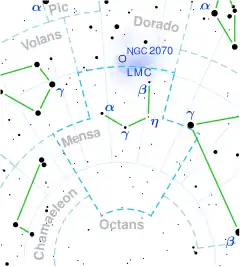 | |
| Observation data Epoch J2000 Equinox J2000 | |
|---|---|
| Constellation | Mensa |
| Right ascension | 05h 35m 36.1787s[1] |
| Declination | −78° 49′ 15.129″[1] |
| Apparent magnitude (V) | 6.00 - 6.05[2] |
| Characteristics | |
| Spectral type | B8 III[3] |
| B−V color index | −0.022[4] |
| Variable type | Ellipsoidal?[2] |
| Astrometry | |
| Radial velocity (Rv) | 12.6±4.3[5] km/s |
| Proper motion (μ) | RA: +5.547[1] mas/yr[1] Dec.: +25.710[1] mas/yr[1] |
| Parallax (π) | 3.7076 ± 0.1819 mas[1] |
| Distance | 880 ± 40 ly (270 ± 10 pc) |
| Absolute magnitude (MV) | −1.03[6] |
| Details | |
| Mass | 3.6[1] M☉ |
| Radius | 9.5[1] R☉ |
| Luminosity | 301[1] L☉ |
| Surface gravity (log g) | 3.4[7] cgs |
| Temperature | 11,272±264[8] K |
| Metallicity [Fe/H] | +0.13[9] dex |
| Age | 203[1] Myr |
| Other designations | |
| Database references | |
| SIMBAD | data |
Iota Mensae is a single star about 880 light years away in the faint constellation Mensa. It has a very slightly variable apparent magnitude of 6.0, making it visible with the naked eye under good skies.
Iota Mensae has a spectral type of B8III, indicating that it has exhausted hydrogen at its core and expanded away from the main sequence. It is about 3.6 times the mass (M☉), 301 times as luminous, and has swollen to 9.5 times the radius of the Sun (R☉). It is calculated to be 314 million years old.
It has been catalogued as a chemically peculiar star with abnormally strong lines of silicon in its spectrum but this classification is now considered doubtful.[11] Its brightness varies by a few hundredths of a magnitude. Its period was initially measured at 2.6 days,[12] but this is now considered to be a period of 5.3 days with primary and secondary minima of a similar depth. The variability is thought to be due to the rotation of the star.[2]
References
- 1 2 3 4 5 6 7 8 9 10 11 Vallenari, A.; et al. (Gaia collaboration) (2023). "Gaia Data Release 3. Summary of the content and survey properties". Astronomy and Astrophysics. 674: A1. arXiv:2208.00211. Bibcode:2023A&A...674A...1G. doi:10.1051/0004-6361/202243940. S2CID 244398875. Gaia DR3 record for this source at VizieR.
- 1 2 3 Samus, N. N.; Durlevich, O. V.; et al. (2009). "VizieR Online Data Catalog: General Catalogue of Variable Stars (Samus+ 2007-2013)". VizieR On-line Data Catalog: B/GCVS. Originally Published in: 2009yCat....102025S. 1: B/gcvs. Bibcode:2009yCat....102025S.
- ↑ Houk, Nancy (1975). "Michigan catalogue of two-dimensional spectral types for the HD stars". University of Michigan Catalogue of Two-Dimensional Spectral Types for the Hd Stars. Volume I. Declinations -90_ to -53_Ƒ0. Ann Arbor, Michigan: Dept. of Astronomy, University of Michigan. 1. Bibcode:1975mcts.book.....H.
- ↑ Høg, E.; Fabricius, C.; Makarov, V. V.; Urban, S.; Corbin, T.; Wycoff, G.; Bastian, U.; Schwekendiek, P.; Wicenec, A. (March 2000). "The Tycho-2 catalogue of the 2.5 million brightest stars". Astronomy and Astrophysics. 355: L27–L30. Bibcode:2000A&A...355L..27H. ISSN 0004-6361.
- ↑ Gontcharov, G. A. (November 2006). "Pulkovo Compilation of Radial Velocities for 35 495 Hipparcos stars in a common system". Astronomy Letters. 32 (11): 759–771. arXiv:1606.08053. Bibcode:2006AstL...32..759G. doi:10.1134/S1063773706110065. ISSN 1063-7737. S2CID 119231169.
- ↑ Anderson, E.; Francis, Ch. (2012). "XHIP: An extended hipparcos compilation". Astronomy Letters. 38 (5): 331. arXiv:1108.4971. Bibcode:2012AstL...38..331A. doi:10.1134/S1063773712050015. S2CID 119257644.
- ↑ Lafrasse, Sylvain; Mella, Guillaume; Bonneau, Daniel; Duvert, Gilles; Delfosse, Xavier; Chesneau, Olivier; Chelli, Alain (16 July 2010). "Building the 'JMMC Stellar Diameters Catalog' using SearchCal". Optical and Infrared Interferometry II. Vol. 7734. pp. 77344E. arXiv:1009.0137. Bibcode:2010SPIE.7734E..4EL. doi:10.1117/12.857024. S2CID 32097037.
- ↑ Stassun, Keivan G.; et al. (9 September 2019). "The Revised TESS Input Catalog and Candidate Target List". The Astronomical Journal. 158 (4): 138. arXiv:1905.10694. Bibcode:2019AJ....158..138S. doi:10.3847/1538-3881/ab3467. ISSN 0004-6256.
- ↑ Anders, F.; et al. (February 2022). "Photo-astrometric distances, extinctions, and astrophysical parameters for Gaia EDR3 stars brighter than G = 18.5". Astronomy & Astrophysics. 658: A91. arXiv:2111.01860. Bibcode:2022A&A...658A..91A. doi:10.1051/0004-6361/202142369. eISSN 1432-0746. ISSN 0004-6361.
- ↑ "Iota Men". SIMBAD. Centre de données astronomiques de Strasbourg. Retrieved 2021-02-18.
- ↑ Renson, P.; Manfroid, J. (2009). "Catalogue of Ap, HGMN and Am stars". Astronomy and Astrophysics. 498 (3): 961. Bibcode:2009A&A...498..961R. doi:10.1051/0004-6361/200810788.
- ↑ Grønbech, B.; Naqvi, S. I. H. (1976). "HR 1991. A new variable B star". Astronomy and Astrophysics Supplement Series. 26: 147. Bibcode:1976A&AS...26..147G.